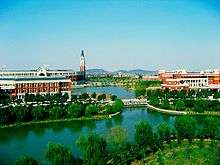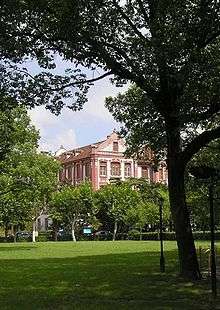Education in Shanghai
Education in Shanghai includes five years of primary education, four years of junior secondary education, and three years of senior secondary education, as well as higher education, including universities and colleges.
Tertiary education

Shanghai is a major center of higher education in China with over 30 universities and colleges. A number of China's most prestigious universities are based in Shanghai, including Fudan University, Shanghai Jiao Tong University, Tongji University, East China Normal University (these universities are selected as "985 universities" by the Chinese Government in order to build world-class universities). In 2002, Fudan University established a joint EMBA program with Washington University in St. Louis, which has since been consistently ranked as one of the best in the world.[1][2] In 2012, NYU Shanghai was established in Pudong by New York University in partnership with East China Normal University as the first Sino-US joint venture university. In 2013 the Shanghai Municipality and the Chinese Academy of Sciences founded the ShanghaiTech University in the Zhangjiang Hi-Tech Park in Pudong. This new research university is aiming to be a first-class institution on a national and international level.[3] The cadre school China Executive Leadership Academy in Pudong is also located in Shanghai, as well as the China Europe International Business School.
Historically Shanghai was a center of higher education. In 1949 it, which at the time held 1.43% of the people in the country, had 41 institutions of higher education, 20% of the country's total number of such.[4]
Primary and secondary education

The city government's education agency is the Shanghai Municipal Education Commission.
Children with foreign passports are permitted to attend any public school in Shanghai. Prior to 2007 they were permitted to attend 150 select public schools. In 2006 about 2,000 non-Chinese nationals under 18 years of age attended Shanghai public schools.[5] Students with Hanyu Shuiping Kaoshi (HSK) above 3 or 4 may attend public schools using Mandarin Chinese as the medium of instruction, while students below HSK 3–4 may attend international divisions of public schools or private international schools.[6]
Shanghai ranked first in the 2009 and 2012 Program for International Student Assessment (PISA), a worldwide study of academic performance of 15-year-old students conducted by the OECD. Shanghai students, including migrant children, scored highest in every aspect (math, reading and science) in the world. The study concludes that public-funded schools in Shanghai have the highest educational quality in the world.[7][8] Critics of PISA results counter that, in Shanghai and other Chinese cities, most children of migrant workers can only attend city schools up to the ninth grade, and must return to their parents' hometowns for high school due to hukou restrictions, thus skewing the composition of the city's high school students in favor of wealthier local families.[9]
The 2010 census shows that out of Shanghai's total population, 22.0% had a college education, double the level from 2000, while 21.0% had high school, 36.5% middle school, and 1.35% primary school education. 2.74% of residents age 15 and older were illiterate.[10]
As of 2011 Shanghai has more than 930 kindergartens, 1,200 primary and 850 middle schools. Over 760,000 middle schools students and 871,000 primary school students are taught by 76,000 and 64,000 teaching staff respectively.[11]
The city government has a financing scheme meant to spread resources to lower income areas by collecting taxes from all areas and then redistributing the money according to need.[12]
History
In the late Qing Dynasty, school districts were introduced into Shanghai, allowing for communities to set local education policies and making education more common. By 1936, 59% of children total were enrolled in educational institutions; of those enrolled in school, about two-thirds were boys and the rest were girls. Grace C. L. Mak and Leslie N. K. Lo, authors of "Education," wrote that education in the city was "way ahead the rest of China" in 1949 although those standards would have been "weak" in 1996.[4] Virtually all children of primary school age in urban areas in the city were enrolled in school by 1958, and by 1983 the same went for children of those ages in rural areas of Shanghai Municipality.[4] Shanghai was the first city in the country to implement 9-year mandatory education consisting of elementary school and junior high school.[13] The city previously designated "key schools" or favored schools which received more resources than others, but ended the system in 1994.[14]
A third party management system called "entrusted management", in which low performing schools received outside management, was given trials in 2005 and permanently established in 2007.[15]
International schools
As of 2019 Shanghai had about 20 international schools.[16] As of 2015 Shanghai has the largest number of international schools of any city in China. In November 2015 Christopher Cottrell of the Global Times wrote that Shanghai "prides itself on its international schools".[17]
International schools include:
- Adcote School Shanghai
- Britannica International School Shanghai
- Bond Canadian Academy
- The British International School Shanghai, Puxi Campus
- Canadian International Academy
- Canadian Trillium College
- Concordia International School Shanghai
- Dulwich College Shanghai
- Fudan International School
- German School Shanghai
- Harrow Shanghai
- Hong Qiao International School - Rainbow Bridge International School
- International Philippine School Shanghai
- Lycée Français de Shanghai
- Maple Leaf International High School — Shanghai
- Nord Anglia International School Shanghai Pudong
- Nord Anglia Chinese International School
- Russian Consulate School in Shanghai (Russian: Начальная общеобразовательная школа при Генеральном консульстве Российской Федерации в Шанхае)[18]
- Shanghai American School
- Shanghai Community International School
- Shanghai High School International Division
- Shanghai Japanese School
- Shanghai Korean School
- Shanghai Livingston American School
- Shanghai Pinghe School
- Shanghai Singapore International School
- Shanghai United International School
- The SMIC Private School
- Shanghai World Foreign Language Middle School
- Wellington College International Shanghai
- Western International School of Shanghai
- YK Pao School
- Yew Chung International School of Shanghai
Defunct:
References
- Zhang, Minxuan, Jinjie Xu, and Chuangyuan Sun. "Effective Teachers for Successful Schools and High Performing Students: The Case of Shanghai" (Chapter 9). In: Lee, Sing Kong, Wing On Lee, and Ee Ling Low (editors). Educational Policy Innovations: Levelling Up and Sustaining Educational Achievement. Springer Science & Business Media, 27 October 2013. ISBN 9814560081, 9789814560085. Start: p. 143.
Notes
- "Executive MBA in Shanghai | WashU Olin Business School". olin.wustl.edu. Retrieved 2020-02-29.
- "Business school rankings from the Financial Times - FT.com". rankings.ft.com. Retrieved 2020-02-29.
- Rouhi, Maureen (19 January 2015). "ShanghaiTech Aims To Raise The Bar For Higher Education In China" Archived 19 November 2015 at the Wayback Machine. Chemical & Engineering News. Retrieved on 19 November 2015.
- Mak, Grace C. L. and Leslie N. K. Lo. "Education" (Chapter 15). In: Yeung, Y. M. and Sung Yun-wing (editors). Shanghai: Transformation and Modernization Under China's Open Policy. The Chinese University Press, 1996. ISBN 9622016677, 9789622016675. Start: p. 135. CITED: p. 378.
- "Neighborhood Schools Open to Foreign Kids " (Archive). Shanghai Daily at China.org.cn. 9 December 2006. Retrieved 16 July 2015.
- Lau, Jessie. "Shanghai international schools are priced beyond the reach of many expats Archived 14 September 2015 at the Wayback Machine" (print title: "International schools out of reach for many"). South China Morning Post. Sunday 13 September 2015. Retrieved on 14 September 2015.
- Dillon, Sam (7 December 2010). "In PISA Test, Top Scores From Shanghai Stun Experts". The New York Times. Archived from the original on 12 May 2011. Retrieved 17 May 2011.
- "How China is winning the school race". BBC. 11 October 2011. Archived from the original on 2 November 2018. Retrieved 21 July 2018.
- Gao, Helen (23 January 2014), "Shanghai Test Scores and the Mystery of the Missing Children" Archived 19 February 2014 at the Wayback Machine, The New York Times. For Schleicher's response to these criticisms see his post, "Are the Chinese Cheating in PISA Or Are We Cheating Ourselves?" on the OECD's website blog, Education Today, 10 December 2013. Archived 17 February 2014 at the Wayback Machine
- 上海市2010年第六次全国人口普查主要数据公报 [Shanghai sixth national census in 2010 Communiqué on Major Data]. Shanghai Municipal Statistics Bureau. 3 May 2011. Archived from the original on 26 November 2011. Retrieved 16 August 2011.
- "General Aspects of Shanghai Education". Seaie.org. Archived from the original on 17 March 2011. Retrieved 17 May 2011.
- Liang, Xiaoyan, Huma Kidwai, Minxuan Zhang, and Yinan Zhang. How Shanghai Does It: Insights and Lessons from the Highest-Ranking Education System in the World.World Bank Publications, 8 April 2016. ISBN 1464807914, 9781464807916. p. 60. DOI: 10.1596/978-1-4648-0790-9.
- Zhang, Xu, and Sun, p. 143.
- Liang, Xiaoyan, Huma Kidwai, Minxuan Zhang, and Yinan Zhang. How Shanghai Does It: Insights and Lessons from the Highest-Ranking Education System in the World.World Bank Publications, 8 April 2016. ISBN 1464807914, 9781464807916. p. 60-61. DOI: 10.1596/978-1-4648-0790-9.
- Liang, Xiaoyan, Huma Kidwai, Minxuan Zhang, and Yinan Zhang. How Shanghai Does It: Insights and Lessons from the Highest-Ranking Education System in the World.World Bank Publications, 8 April 2016. ISBN 1464807914, 9781464807916. p. 61. DOI: 10.1596/978-1-4648-0790-9.
- "Education in Shanghai". City of Shanghai. Retrieved 2019-07-11.
- Cottrell, Christopher. "Elitist international schools biased against local hires Archived 12 November 2015 at the Wayback Machine." Global Times. 8 November 2015. Retrieved on 10 November 2015.
- "Специализированные структурные образовательные подразделения МИД России (заграншколы МИД России) (официальные сайты)". Russian Ministry of Foreign Affairs. 2014-11-11. Archived from the original on 2015-06-27. Retrieved 2019-07-11.
35 КНР Шанхай http://schoolshanghai.ru/
- Current official website- Archived 2018-08-20 at the Wayback Machine
Further reading
- Tucker, Marc S. Surpassing Shanghai: An Agenda for American Education Built on the World's Leading Systems. Harvard Education Press, 1 November 2011. ISBN 1612504574, 9781612504575.

